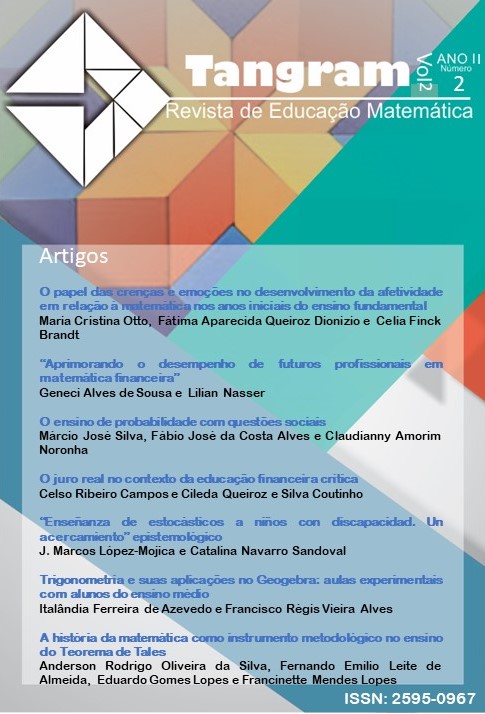Enseñanza de estocásticos a niños con discapacidad. Un acercamiento epistemológico
DOI:
https://doi.org/10.30612/tangram.v2i2.9013Keywords:
matemáticas escolares, probabilidad, estadística, discapacidadAbstract
En el presente documento se informa sobre una experiencia de enseñanza al introducir los temas de probabilidad y de estadística a niños con discapacidad del segundo grado (8-10 años) de educación especial. El interés fue documentar el proceso de enseñanza y, con base en ello, analizar el desempeño de los estudiantes ante una situación aleatoria. Para lo anterior fueron necesarios los elementos: epistemológico, cognitivo y social. Se aplicó una actividad de enseñanza para promover la comprensión de ideas fundamentales de estocásticos ante la presencia de la docente titular y el investigador. Los resultados muestran un acercamiento a nociones de espacio muestra, medida de probabilidad y variable aleatoria (frecuencias relativas). Se concluye necesario e imperante el tratamiento de fenómenos aleatorios en este nivel educativo de manera sistemática para ofrecer una matemática básica integral; además los estocásticos provocaron dotar de sentido a otros conceptos matemáticos por su uso.Downloads
References
Bruno, A., Noda, M., Aguilar, R., González, C., Moreno, L. y Muñoz, V. (2006). Análisis de un tutorial inteligente sobre conceptos lógico-matemáticos en alumnos con síndrome de Down. Revista Latinoamericana en Matemática Educativa, 9(2), 211-226.
Fischbein, E. (1975). The intuitive sources of probabilistic thinking in children. Holanda: Reidel.
Gaviria, Y. R., Torres, J. J., y Torres, E. (2014). Una propuesta inclusiva para la representación geométrica de los poliedros con población en condición de discapacidad visual. Infancias Imágenes, 13(2), 111-125.
DOI: https://doi.org/10.14483/udistrital.jour.infimg.2014.2.a09
Heitele, D. (1975). An Epistemological View on Fundamental Stochastic Ideas. Educational Studies in Mathematics 6(2), 187-205.
Ley General para las Personas con Discapacidad (2008, 1 de agosto). Diario Oficial de la Federación, México.
López-Mojica, J. M., Ojeda, A. M. y Salcedo, J. (2018). Ideas fundamentales de estocásticos en libros de texto de educación primaria: una alternativa de enseñanza. IE Revista de Investigación Educativa de la REDIECH, 9(17), 87-102.
Ojeda, A. M. (2006). Estrategia para un perfil nuevo de docencia: un ensayo en la enseñanza de estocásticos. En Filloy (Ed.) Matemática Educativa, treinta años (pp. 195-214). México: Santillana-Cinvestav.
Secretaría de Educación Pública (2004). Licenciatura en Educación Especial. Programa para la Transformación y el Fortalecimiento Académicos de las Escuelas Normales. Plan de estudios. México: SEP.
Secretaría de Educación Pública (2006). Libro de matemáticas segundo grado. México: SEP.
Secretaría de Educación Pública (2011). Planes y programas de estudio 2011. Educación Básica. México: SEP.
Steinbring, H. (2005). The Construction of new Mathematical Knowledge in Classroom Interaction. USA: Springer.
Tversky, A. y Kahneman, D. (1982). Availability: A heuristic for judging frequency and probability. En D. Kahneman, P. Slovic y A. Tversky (Eds.), Judgment under uncertainty: Heuristics and biases. EEUU: University Press.
Vygotski, L. S. (1997). Fundamentos de la Defectología. Obra Escogidas V. España: Visor Dis.
Downloads
Published
How to Cite
Issue
Section
License
Authors must accept the publication rules when submitting the journal, as well as agree to the following terms:
(a) The Editorial Board reserves the right to make changes to the Portuguese language in the originals to maintain the cultured standard of the language, while respecting the style of the authors.
(b) Authors retain the copyright and grant the journal the right to first publication, with the work simultaneously licensed under the Attribution-NonCommercial-ShareAlike 3.0 Brazil (CC BY-NC-SA 3.0 BR) that allows: Share - copy and redistribute the material in any medium or format and Adapt - remix, transform, and create from the material. CC BY-NC-SA 3.0 BR considers the following terms:
- Attribution - You must give the appropriate credit, provide a link to the license and indicate whether changes have been made. You must do so under any reasonable circumstances, but in no way that would suggest that the licensor supports you or your use.
- NonCommercial - You may not use the material for commercial purposes.
- Sharing - If you remix, transform, or create from material, you must distribute your contributions under the same license as the original.
- No additional restrictions - You may not apply legal terms or technological measures that legally restrict others from doing anything that the license permits.
(c) After publication, authors are allowed and encouraged to publish and distribute their work online - in institutional repositories, personal page, social network or other scientific dissemination sites, as long as the publication is not for commercial purposes.






